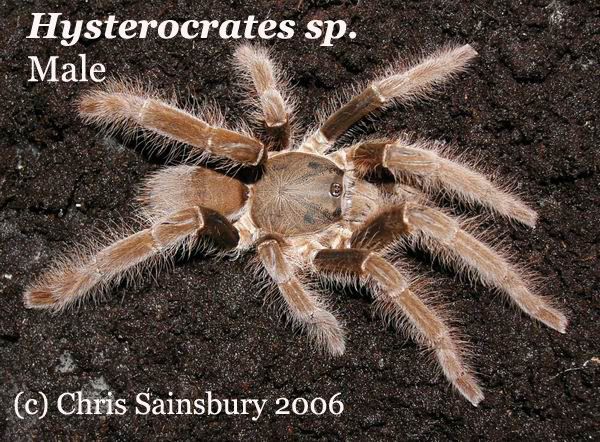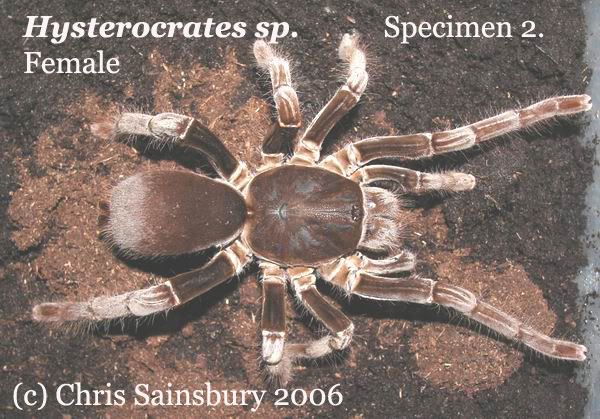- Joined
- Aug 7, 2002
- Messages
- 676
Taxonomy problems with this genus
Martin and all:
Yes, your quotes of Rick West's posts confirm what I have been saying - the genus needs revision badly.
Let's explore a typical pet trade problem.
Trusted and knowledgeable European dealer "X" has on his pricelist "Hysterocrates hercules" (along with H. gigas) spiderlings. When the American buyer inquires about these "hercules", the European dealer says they are the real hercules and shows a picture of the mother with ruler in the background. The photo shows a dark brown Hysterocrates with olive leg hairs, an oval carapace, hind legs proportional and close to being the same length of the front legs and a legspan just over 8 inches. Fairly convincing based on what we read is the real hercules, right?
American buyer imports these and sells them as H. hercules. Spiderlings are grown up and 2-3 years later, hobbyists see the hind legs being a little longer and stronger than the front legs and the carapace seems elongated. Here is the classic problem we have had in the U.S. hobby for the last ten years. Mark Hart, Frank Somma, Bryant Capiz and myself have all experienced this situation. Did we deliberately deceive buyers by selling them as H. hercules? No. Did the European exporter? Probably not. Are all three, the American importer, the European exporter and the original European breeder all out to deceive hobbyists with this name? No. The problem is the genus needs revision badly. We really don't know 100% what we have, we can only go with the information give to us at the time and what he read to name this spider.
We can sell them technically as "Hysterocrates sp. (poss. H. hercules)" , but hobbyists will shorten that long name to Hysterocrates hercules anyway. I agree dealers should have the goal of selling their stock with locality information, BUT there are three classic problems in our trade in fulfilling that goal.
One, collectors don't want to reveal their collecting areas and two, collectors don't care to record this information, and three exporters don't care and often put out short pricelists with just basic info to fit on their pricelists such as scientific name, size and price. You rarely get a description and locality info. That's a joke.
So, you see, we might all like these Hysterocrates spp., but until the genus is revised, species level identifications will be highly controversial and debated, especially the elusive H. hercules.
One thing has happened because of the hercules problem. Back in the early '90s of the American hobby, "H. hercules" sold for $95 for spiderlings and $350 for adults. Because of the controversial debate on the correct ID if this spider, prices have came way down and leveled out to reflect this problem. Anybody selling "H. hercules" in the American hobby can't ask for those prices anymore. "H. hercules" spiderlings typically only sell for 25-50% more than "H. gigas", or "H. crassipes" spiderlings, and since Rick West's Cameroon trip two years ago and the findings reported, "H. gigas" has actually increased in price and appreciation now that American hobbyists realize that 75% of what was imported the last ten years was not "H. gigas", but instead "H. crassipes". Now, real "H. gigas" is highly appreciated in hobbyists collections.
Again, things have changed and opinions change with them. Everbody needs to stay open-minded and flexible about this Hysterocrates hercules debate. Until the genus is revised, it's interesting to debate this topic, but we will be spinning our wheels here.
Todd
Todd
Martin and all:
Yes, your quotes of Rick West's posts confirm what I have been saying - the genus needs revision badly.
Let's explore a typical pet trade problem.
Trusted and knowledgeable European dealer "X" has on his pricelist "Hysterocrates hercules" (along with H. gigas) spiderlings. When the American buyer inquires about these "hercules", the European dealer says they are the real hercules and shows a picture of the mother with ruler in the background. The photo shows a dark brown Hysterocrates with olive leg hairs, an oval carapace, hind legs proportional and close to being the same length of the front legs and a legspan just over 8 inches. Fairly convincing based on what we read is the real hercules, right?
American buyer imports these and sells them as H. hercules. Spiderlings are grown up and 2-3 years later, hobbyists see the hind legs being a little longer and stronger than the front legs and the carapace seems elongated. Here is the classic problem we have had in the U.S. hobby for the last ten years. Mark Hart, Frank Somma, Bryant Capiz and myself have all experienced this situation. Did we deliberately deceive buyers by selling them as H. hercules? No. Did the European exporter? Probably not. Are all three, the American importer, the European exporter and the original European breeder all out to deceive hobbyists with this name? No. The problem is the genus needs revision badly. We really don't know 100% what we have, we can only go with the information give to us at the time and what he read to name this spider.
We can sell them technically as "Hysterocrates sp. (poss. H. hercules)" , but hobbyists will shorten that long name to Hysterocrates hercules anyway. I agree dealers should have the goal of selling their stock with locality information, BUT there are three classic problems in our trade in fulfilling that goal.
One, collectors don't want to reveal their collecting areas and two, collectors don't care to record this information, and three exporters don't care and often put out short pricelists with just basic info to fit on their pricelists such as scientific name, size and price. You rarely get a description and locality info. That's a joke.
So, you see, we might all like these Hysterocrates spp., but until the genus is revised, species level identifications will be highly controversial and debated, especially the elusive H. hercules.
One thing has happened because of the hercules problem. Back in the early '90s of the American hobby, "H. hercules" sold for $95 for spiderlings and $350 for adults. Because of the controversial debate on the correct ID if this spider, prices have came way down and leveled out to reflect this problem. Anybody selling "H. hercules" in the American hobby can't ask for those prices anymore. "H. hercules" spiderlings typically only sell for 25-50% more than "H. gigas", or "H. crassipes" spiderlings, and since Rick West's Cameroon trip two years ago and the findings reported, "H. gigas" has actually increased in price and appreciation now that American hobbyists realize that 75% of what was imported the last ten years was not "H. gigas", but instead "H. crassipes". Now, real "H. gigas" is highly appreciated in hobbyists collections.
Again, things have changed and opinions change with them. Everbody needs to stay open-minded and flexible about this Hysterocrates hercules debate. Until the genus is revised, it's interesting to debate this topic, but we will be spinning our wheels here.
Todd
Todd
Last edited:





